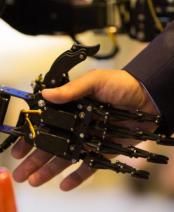FibsDip

The project FibsDip was a 2023 and 2024 winner of the PREMATURATION call for projects, led by the Innovation Lab of IP Paris.
THE PROBLEM ADDRESSED
Although technical solutions exist to aid patients and restore their mobility, clinical complications are frequent, and too many patients still give up using prostheses. Prosthetists, on the front line in this care, lack precise indicators and are required to review their patients several times before determining an acceptable solution. They have highlighted real difficulties in determining, quickly and reliably, the most critical areas for patients (pain, friction). The difficulties, therefore, remain for prosthetists who must base themselves on the patients' feelings to adapt the sockets. Fiber Bragg gratings (FBGs) are sensors on optical fibers that accurately measure pressure and shear. By integrating these FBGs into a pressure patch and strategically placing it, pressure points can be precisely identified, enabling the prosthesis to be optimally customized to the individual.
TECHNOLOGY
The device consists of a patch with optical fiber integrating FBGs as sensors, allowing to measure the distribution of pressures in different areas, without hindering the patient's movements.
Bragg Gratings enable precise estimation of pressures and shears.
Different geometries of sensors integrating a different number of sensors have already been tested.
COMPETITIVE ADVANTAGES
Pressure measurements with precision, accuracy and repeatability at the interface between the liner and the socket, during walking for lower limb amputees.
A connected, robust, non-invasive, small, easy-to-use device, allowing it to be positioned without disturbing the use of prostheses.
A device adaptable to different parts of the body, patient populations and pathologies.















